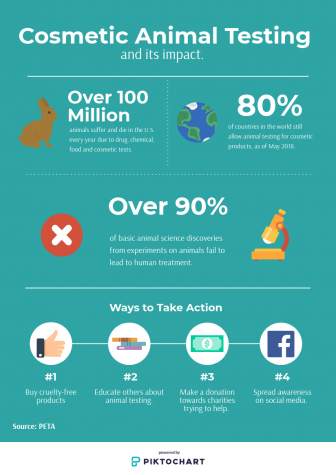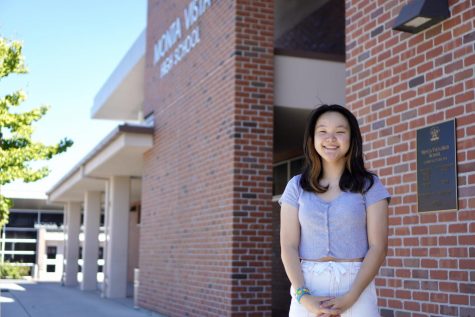Beauty and the Blood
MVHS individuals voice their opinions about cosmetic animal testing.

September 28, 2018
Cosmetic testing is the process of testing makeup products and their ingredients on animals through brutal and violent manners when checking for severe reactions on their skin. When this process is complete, blood is shed and lives are lost, but beauty is found — both inside and out.
Sophomore Elene Pilpani believes that makeup has affected the way she feels about herself: not just the physical application but it also offers her a boost of confidence and self-esteem.
“I do enjoy wearing makeup. It makes me more self-confident, even though I don’t wear a lot,” Pilpani said. “If I put on mascara, concealer and lip gloss, it makes me feel better about myself.”
Makeup can also be an outlet to express one’s artistic self. Junior Naomi Desai, an art-lover, uses makeup to express her creativity and style as well as how she is seen amongst her friends and peers.
“I normally wear it for fun because I’m an art person so for me, it’s self-expression more than because I have to,” Desai said.
As Desai uses makeup products to express herself, she states the importance of using certain products — specifically, cruelty-free products.
“I don’t know that many others but I think a lot of brands are starting to [make cruelty-free products] because a lot of people, like me, use a lot of makeup and don’t want to harm animals in the process,” Desai said.
According to Humane Society International, testing on animals is both inhumane and inaccurate as tests are proven to be successful less than 10% of the time. It is also “estimated that approximately 100,000 to 200,000 animals suffer and die just for cosmetics every year around the world.”
While Desai approaches the ethics behind the alternative makeup choices, Pilpani finds it more important to compare the overall quality of the makeup, regardless of whether or not it is animal tested.
“I would rather use products that aren’t being animal tested, but if I really want a product, it works really well, and [used] animal testing, I don’t think it would necessarily steer me away from it,” Pilpani said. “I’d feel bad, but if it’s a good product [then that’s it].”

In contrast to these two perspectives, science teacher Julie Choi believes that it is important for a product to provide its label with all of its packaging information regarding whether if it is made with testing or not.
“I don’t think people are completely opposed to not going [with] animal-free cosmetics necessarily, it’s more of people don’t know from the packages that they buy [and] it’s hard to tell, so more awareness is a good thing,” Choi said.
According to a nationwide survey conducted by VitaCost, Leaping Bunny, 74.6% of the people said that they would purchase a labeled “cruelty-free” product over one without it, if price and quality were equal.
Individuals who aim to use cruelty-free cosmetic products often have to spend more as these products are more expensive compared to animal tested products. Desai addresses this issue about cruelty-free cosmetics and how that could raise hesitancy with the quality of the product as well.
“The price is definitely a big part of it, like when they say they don’t harm animals, it’s normally made somewhere in the U.S. where manufacturing is more expensive,” Desai said. “So that plays a role [there, but] sometimes the quality isn’t necessarily as good and the range of colors [offered] isn’t necessarily the same.”
Choi also refers to the common concern of higher pricing and believes in the value of understanding the purchase made, rather than making a blind transaction. She emphasizes the cruciality of knowing what is being bought, so the person buying the product can make a decision on the spot based on whether or not the product is tested.
“If it was written in large block letters on the product, I would definitely choose one over the other even if the price point was higher, but I think it takes more research and is not as well advertised [either],” Choi said. “It’s one of those things where you have to do your research to find out and I find that to be unfortunate.”
However, Pilpani makes it clear that the quality of the product can influence someone what to buy more than its cost; while she agrees to the ethical side of the alternative, she states that making sure that the product is of high standards is more significant.
“[Cosmetic testing] is a bad thing and [while] cost doesn’t really matter, I’m going to look for the product that works,” Pilpani said. “Even if it’s not the right thing to do necessarily, I don’t think that’s going to stop me from using a product.”
Choi adds on believing that if a product is crafted to support a cause like going cruelty-free, then its quality and market values will be of that high standard.
“I understand that the price point will be high, but I think the price points are high for a reason,” Choi said. “Cosmetics, in general, are a little expensive, for what they are but that’s just the market so would I be willing to pay? Yeah, I’d be willing to pay.”


















